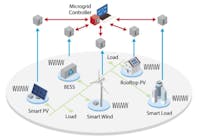Looking ahead, there are both great opportunities and great challenges in modernizing the electric power delivery system. I have compiled what I believe to be the top seven issues facing grid modernization:
#7: Use of Big Data — The smart grid generates a LOT of data. For example, monthly meter reads are being replaced by hourly or more frequent reads, increasing the amount of data by about 1000 times. Used effectively, this data provides some great opportunities. For example:
- Comparing the sum of revenue meters with the feeder meters on a given circuit could be used to identify anomalies. Subsequent field work could identify theft of service or unusual losses.
- Phase-to-phase comparisons could identify unbalanced conditions that result preventable system losses.
Reducing losses by even a small percentage can yield significant benefits. If a hypothetical utility has one million customers using 1000 kWh per month and charges US$0.15 per kWh, just 1% more revenue equates to US$1.5M per month.
The challenge is to implement the systems and processes to convert these opportunities into savings.
#6: Electrification of Transportation — Roughly speaking, transportation uses about one-third of all U.S. energy. Since it is nearly entirely powered by burning fossil fuels, transportation results in an even greater proportion of U.S. emissions. What a great opportunity for improvement.
Electric and hybrid vehicles exist today. They offer more efficient operation resulting in more miles per gallon and/or an opportunity to substitute electric power’s mix of fuel sources in place of petroleum products.
The challenges include vehicle prices, the availability of charging stations, and the duration of recharging. Even so, we are seeing growth in the adoption of electric vehicles.
#5: More (Renewable) Power — Another great opportunity! According to the U.S. Energy Information Administration, about 17% of U.S. electricity generation is from renewable sources. With utility-scale storage and additional distributed, renewable generation, this proportion has room to more than double. The challenges include cost and hosting capacity:
- The cost of battery storage continues to drop as the technology advances on the learning curve.
- Hosting capacity refers to the ability of a distribution circuit to support renewable generation. This challenge grows on each distribution circuit every time a new solar system or wind turbine is added.
#4: Defense — Power delivery networks are becoming more interconnected with control and communication systems. Supervisory Control and Data Acquisition has long been used for power transmission networks. SCADA is now being added to distribution systems. Smart meters add two-way communications, often with remote on/off capability, at the points of customer connections. Field area networks are being installed to allow remote control of customer-owner generation.
All of these developments add functional control but also add new vulnerabilities. Utilities are increasingly concerned about physical and cybersecurity. Further, there are concerns about geomagnetic disturbances and the possibility of a severe electromagnetic pulse from a high-altitude nuclear detonation. These challenges also create opportunities as vendors develop products to help utilities reduce these operational risks.
#3: Resilience — Here’s a big challenge: how to improve delivery system resilience, even as all the equipment ages and the vegetation grows every day.
The opportunity is to develop improved design and maintenance standards and provide compelling evidence to help gain their adoption with various stakeholder groups (including customers and regulators). For example, “blue sky” tree trimming removes all overhanging branches resulting in superior resilience, but it costs a lot more!
#2: Regulatory Policy — In the U.S., each state sets regulatory policies that can drive changes in the power industry. In many states, conservation programs have long helped implement cost-beneficial measures like more efficient lighting, which reduces bills by reducing usage. Additional opportunities including utility ownership of batteries and/or charging stations can help promote the adoption of these technologies. Renewable portfolio standards can create markets for wind and solar generation. Numerous pilot projects confirm that rate design can provide incentives to promote improved demand response. All of these options are opportunities for state policy makers and regulators.
There are also challenges. Incentives cost money! They can be expensive to electric customers and may be greater than needed to obtain the desired changes.
#1: People — The top opportunity and challenge is people! The grid is becoming more and more complex in both design and operation. This complexity demands increased capabilities in utility engineers, electricians and line workers. At the same time, utilities face a continuing employee demographic challenge as the remaining “baby boomers” retire. Further, the nearly full employment economy means utilities must work harder to hire and retain the top-quality people they need.
The opportunity is for utility employees to grow and learn. I am confident that their success will result in an even better power system: more renewable, more resilient, and more efficient.


